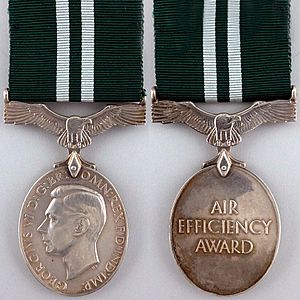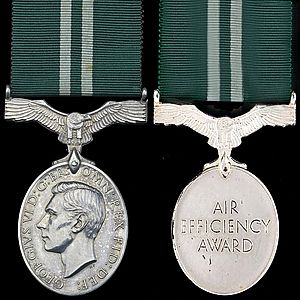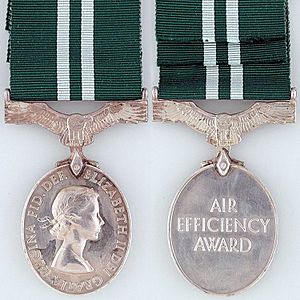Air Efficiency Award facts for kids
Quick facts for kids Air Efficiency Award |
|
|---|---|

First King George VI version
|
|
| Country | |
| Type | Military long service medal |
| Eligibility | Part-time Air Force officers, airmen and airwomen |
| Awarded for | Ten years service |
| Status | Still current in New Zealand |
| Clasps | Ten years additional service |
| Post-nominals | AE (officers only) |
| Statistics | |
| Established | 1942 |
| Order of wear | |
| Next (higher) | Royal Naval Auxiliary Service Medal |
| Next (lower) | Volunteer Reserves Service Medal |
 Ribbon bar |
|
The Air Efficiency Award was a special medal created in 1942. It was given to officers, airmen, and airwomen who served part-time in the Air Forces of the United Kingdom and other countries connected to the British Commonwealth. If you were an officer and received this award, you could use the letters AE after your name.
This award recognized ten years of excellent service. While it is no longer given in the United Kingdom since 1999, it is still awarded in New Zealand. Other countries like Canada, South Africa, and Australia replaced it with their own awards between 1951 and 1975.
Contents
What is the Air Efficiency Award?
The Air Efficiency Award was officially started on August 17, 1942. It was a long-service award for people serving part-time in the Auxiliary and Volunteer Air Forces. This included forces in the United Kingdom, India, Burma, British Colonies, and other British Dominions. A special "clasp" could also be added to the medal for even more service.
At first, people who received the award, whether officers or other ranks, did not get to use letters after their name. This was because the award was unique; it recognized the special teamwork between officers and aircrew. Later, sometime between 1964 and 1982, officers who received the award were allowed to use "AE" after their names.
Countries that Adopted the Award
Several countries that were part of the British Commonwealth adopted the Air Efficiency Award:
- Australia: About 400 Air Efficiency Awards were given out between 1942 and 1975.
- Canada: Canada started using the award in 1942. It replaced older medals for part-time members of the Royal Canadian Air Force. Although there were plans for a Canadian version of the medal, the regular British version was given to Canadians.
- New Zealand: New Zealand adopted the award in 1942 and still gives it out today.
- South Africa: South Africa also adopted the award. There were plans for a special bilingual version, but this never happened. Instead, South Africa created its own set of medals in 1952 to replace all British awards.
The very first Air Efficiency Awards were announced to the public on December 25, 1942.
How to Earn the Air Efficiency Award
To get the Air Efficiency Award, you generally needed ten years of service. At least five of those years had to be actual service in an Auxiliary or Volunteer Air Force. Even Princes or Princesses of the Royal Family could receive this award.
Earning Clasps for More Service
A "clasp" is a bar attached to the medal ribbon. You could earn a clasp for another ten years of service, following the same rules as for the medal itself. You could earn even more clasps for every additional ten years of qualifying service.
Counting Service Time
The way service time was counted could vary:
- For those who started serving before September 3, 1939, their time was counted as one-and-a-half times its actual length.
- During World War II (September 3, 1939, to September 2, 1945), service on flying duties with the Royal Air Force or other Commonwealth Air Forces was counted as triple time.
- Other duties during World War II, while serving within the Royal Air Force, were counted as double time.
- After December 1, 1948, flying service was counted as one-and-a-half times, while other duties were counted as single time.
Where the Award Ranks
Medals and awards have an "order of wear," which means the specific order in which they are worn on a uniform. In the United Kingdom, the Air Efficiency Award is worn after the Royal Naval Auxiliary Service Medal and before the Volunteer Reserves Service Medal.
South Africa's Order of Wear
After April 6, 1952, South Africa introduced its own medals. From that date, older British awards, like the Air Efficiency Award, were still worn. However, they were worn after all South African decorations and medals.
What the Medal Looks Like
The Air Efficiency Award medal is made of silver and is shaped like an oval. It is about 38 millimeters (1.5 inches) high and 32 millimeters (1.25 inches) wide. It has a raised edge on both sides. The medal hangs from a silver bar shaped like an eagle flying, looking to its left.
The Front (Obverse)
The front of the medal shows a picture of the King or Queen who was ruling at the time. There have been four different versions of the medal:
- The first version featured King George VI.
- A second King George VI version was made in 1949. This one removed a reference to India from the inscription.
- The first Queen Elizabeth II version was introduced after she became Queen in 1952.
- A second Queen Elizabeth II version was introduced after her coronation in 1953.
The Back (Reverse)
The back of the medal is smooth and has the words "AIR EFFICIENCY AWARD" written on it in three lines.
The Clasp
The clasp, which is added for extra service, is also made of silver. It has an eagle with its wings spread out, with a crown above it.
The Ribbon
The ribbon for the medal is 38 millimeters (1.5 inches) wide. It has a wide dark green stripe, a pale blue stripe, another dark green stripe, and then the pale blue and dark green stripes repeated in reverse order.
When the Award Ended
Over time, the Air Efficiency Award was replaced by new medals in the United Kingdom and some Commonwealth countries.
- Canada was the first to replace it with the Canadian Forces' Decoration in 1951. However, some members who joined before September 1, 1939, could still receive the Air Efficiency Award.
- South Africa replaced it in 1952 with the John Chard Medal. This medal was for all ranks in the Citizen Force who had twelve years of good service.
- Australia replaced it with the National Medal in 1975.
- In the United Kingdom, the award stopped being given out on April 1, 1999. It was replaced by the Volunteer Reserves Service Medal. However, people could still receive the Air Efficiency Award if their qualifying service ended before April 1, 1999.
As of today, New Zealand continues to award the Air Efficiency Award.
Images for kids



